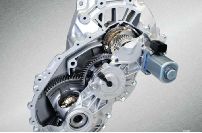GKN, a supplier of automotive driveline components and systems, has produced the industry’s first two-speed eAxle. The technology has entered production on the BMW i8 plug-in hybrid sports car.
GKN Automotive CEO Andrew Reynolds-Smith said: “GKN’s customers aren’t just looking to make their next car more efficient; they want to create new driving experiences. Our expertise in driveline efficiency, torque vectoring and electric drive systems is enabling automakers to connect drivers to the road in new ways. We are developing the systems that are helping bring a new generation of electric drive vehicles to life.”
Theodor Gassmann, GKN Driveline’s Vice President Product Technology eDrive Systems, said: “Being the first Tier One to deliver a two-speed eAxle demonstrates GKN’s leadership in electric drive technologies and hybrid driveline systems. Two-speed eAxles will help manufacturers enhance hybrid and electric drivetrains and support the trend to downsize eMotors to reduce weight and cost. With the technology proven in a high-performance vehicle with high levels of refinement, significant savings in CO2 are possible.”
Giving the electric motor an additional gear ratio improves acceleration and pure electric range, benefiting both driving dynamics and CO2 emissions. GKN’s two-speed eAxle also enables the motor and all its associated systems to be downsized, reducing mass and increasing efficiency.
eAxle technology enables automakers to produce “axle-split hybrids”. A conventional or hybridized engine provides the primary power to either the front or rear wheels, with the other axle driven by an eAxle module. The technology responds intelligently to deliver an instant high-torque all-wheel drive experience, a useful pure electric range or a refined parallel hybrid mode.
Until now electric and axle-split hybrid vehicles have used single-speed transmissions. Using a fixed ratio limits electric drives in terms of either acceleration or top speed as they must disconnect at certain speeds to prevent the motor overspinning. GKN’s two-speed eAxle is the first to enable the electric drive to boost the vehicle’s performance across its entire speed range.
Designing the two-speed eAxle for a high-performance sports car application placed tight packaging requirements on GKN’s development team. To achieve high torque density in a package that weighs 27 kg and measures less than 325 mm by 562 mm by 313 mm, some design decisions were needed.
To make the system narrower, the shift mechanism sits on the input shaft instead of the intermediate shaft in the middle of the transmission. Even with the input shaft spinning at up to 11,400 rpm, GKN’s software control of the eMotor and the synchro-actuation manages the gearshift in all conditions.
“Gear shifts are completely transparent to the driver,” said Gassmann. “The smooth electromechanically actuated shift between the synchronized ratios has enabled our eAxle to set new benchmarks for comfort and NVH. The eAxle combines superior efficiency of 97% with high gear shift comfort and low gear noise. And yet the shift mechanism is a proven technology with components already in series production, providing a robust and cost-effective solution.”
“By drawing on all the expertise and knowledge within GKN’s global engineering network, we were able to take the eAxle from concept to production in 24 months,” said Gassmann. “Going forward, pairing electric powertrains with multi-speed transmissions is enabling GKN to supply downsized eDrive modules for future hybrid and electric vehicles. The technology also enables more radical future eMotor downsizing strategies.”
Source: GKN
Romain’s opinion:
It may be the first two-speed eAxle in production but I think that ZF has already developed one for a prototype. It is however true that all the arguments listed above make sense from the engineering point of view. Why do you think it is not more widely used in electric cars?





















The transmission built into a car axle is the inevitable evolution of the hybrid car. Since hybrids like the i8 are being utilized not just for fuel economy, but for the large amount of instant torque they can provide at the low end, they need a way of harnessing the power of the petrol engine at the high end. ZF, who I work for, has been focused on the basic longitudinal transmissions with electric power for years now. However, I have heard our axle division are working on getting to market with these axle systems but at a lower cost. These axle-transmissions are still quite expensive and you can imagine having four of them on a single car could jack the price way up. Its still good to know that the hybrid technology is moving on past the simple Prius and now is now improving performance of supercars.